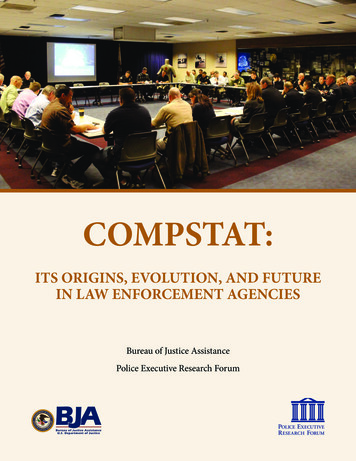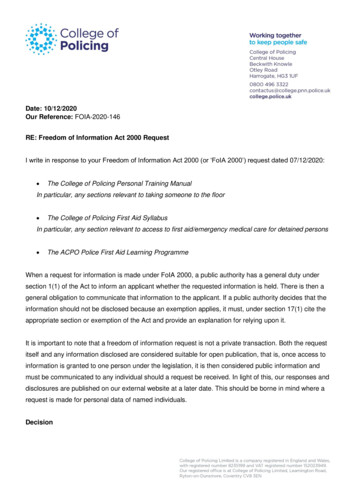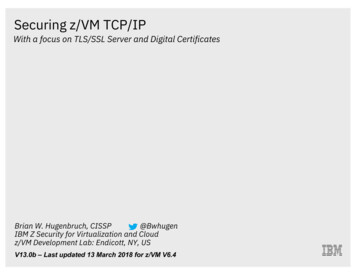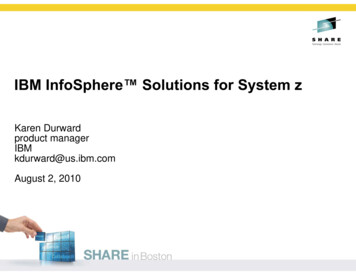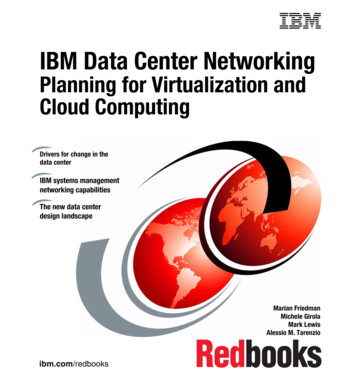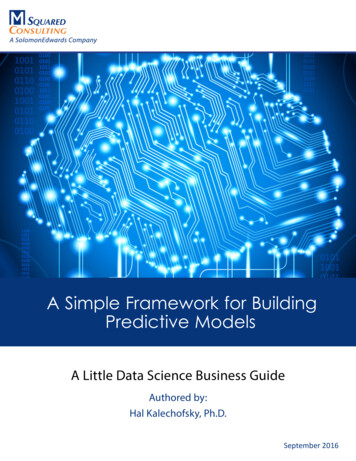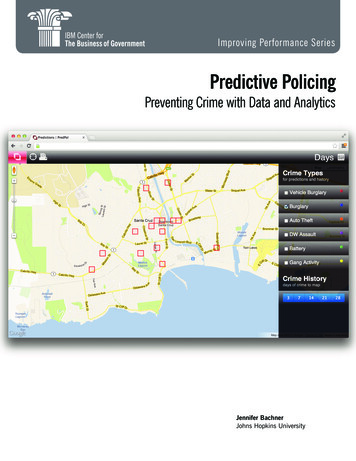
Transcription
Improving Performance SeriesPredictive PolicingPreventing Crime with Data and AnalyticsJennifer BachnerJohns Hopkins University
Improving Performance SeriesPredictive Policing: PreventingCrime with Data and AnalyticsJennifer BachnerJohns Hopkins University2013
Predictive Policing: Preventing Crime with Data and Analyticswww.businessofgovernment.orgTable of ContentsForeword. . . . . . . . . . . . . . . . . . . . . . . . . . . . . . . . . . . . . . . . . . . . . . . . . . . . . . . . . . . 4Understanding Predictive Policing . . . . . . . . . . . . . . . . .Introduction. . . . . . . . . . . . . . . . . . . . . . . . . . . . . .Origins of Crime Analysis. . . . . . . . . . . . . . . . . . . . .The Role of Predictive Analytics in Crime Prevention. .Non-Predictive Uses of Crime Data. . . . . . . . . . . . . .66789Operational Challenges of Predictive Policing . . . . . . . . . . . . . . . . . . . . . . . . . . . . . . . . 11Predicting Crime . . . . . . . . . . . . . . . . . . . . . . . . . . . . . . . . . . . . . .Theoretical Foundations of Data Mining and Predictive Analytics. .Data Used in Predictive Policing. . . . . . . . . . . . . . . . . . . . . . . . .Predictive Methodologies. . . . . . . . . . . . . . . . . . . . . . . . . . . . . .14141517Places on the Frontier of Predictive Policing. .Santa Cruz, California. . . . . . . . . . . . . . .Baltimore County, Maryland. . . . . . . . . . .Richmond, Virginia. . . . . . . . . . . . . . . . .25252729.Implementation Recommendations . . . . . . . . . . . . . . . . . . . . . . . . . . . . . . . . . . . . . . . 31Acknowledgments . . . . . . . . . . . . . . . . . . . . . . . . . . . . . . . . . . . . . . . . . . . . . . . . . . . 33References. . . . . . . . . . . . . . . . . . . . . . . . . . . . . . . . . . . . . . . . . . . . . . . . . . . . . . . . . 34About the Author . . . . . . . . . . . . . . . . . . . . . . . . . . . . . . . . . . . . . . . . . . . . . . . . . . . . 36Key Contact Information. . . . . . . . . . . . . . . . . . . . . . . . . . . . . . . . . . . . . . . . . . . . . . . 373
Predictive Policing: Preventing Crime with Data and AnalyticsIBM Center for The Business of GovernmentForewordOn behalf of the IBM Center for The Business of Government,we are pleased to present this report, Predictive Policing:Preventing Crime with Data and Analytics, by Jennifer Bachner,Center for Advanced Governmental Studies, Johns HopkinsUniversity.There is much discussion now in the worlds of technology andgovernment about social network analysis, business analytics,dashboards, GIS visualization graphics, and the use of “bigdata.” But for non-technical observers, this discussion onlybegins to make sense once tools and technologies show visibleresults for the public. This report seeks to bridge that gap.Daniel J. ChenokDr. Bachner tells compelling stories of how new policingapproaches in communities are turning traditional police officersinto “data detectives.” Police departments across the countrynow adapt techniques initially developed by retailers, such asNetflix and Walmart, to predict consumer behavior; these sametechniques can help to predict criminal behavior. The reportpresents case studies of the experience of Santa Cruz, California;Baltimore County, Maryland; and Richmond, Virginia, in usingpredictive policing as a new and effective tool to combat crime.While this report focuses on the use of predictive techniquesand tools for preventing crime in local communities, thesemethods can apply to other policy arenas as well; Dr. Bachner’swork is consistent with a number of reports on this topic thatthe Center has recently released. Efforts to use predictive analytics can be seen in the Department of Housing and UrbanDevelopment’s initiative to predict and prevent homelessness,and in the Federal Emergency Management Agency’s initiativeto identify and mitigate communities vulnerable to naturaldisasters. These techniques are also being applied to reduce taxfraud and improve services in national parks, as described inother IBM Center reports which include the 2012 report prepared by the Partnership for Public Service, From Data toDecisions II: Building an Analytics Culture.4Gregory J. Greben
Predictive Policing: Preventing Crime with Data and Analyticswww.businessofgovernment.orgWe hope that this report will be highly useful to the lawenforcement community, as well as to government leaders generally, in understanding the potential of predictive analytics inimproving performance in a wide range of arenas.Daniel J. ChenokExecutive DirectorIBM Center for The Business of Governmentchenokd @ us.ibm.comGregory J. GrebenVice PresidentBusiness Analytics & OptimizationPractice Leader, IBM U.S. Public Sectorgreg.greben @ us.ibm.com5
Predictive Policing: Preventing Crime with Data and AnalyticsIBM Center for The Business of GovernmentUnderstanding Predictive PolicingIntroductionDecision-making in all sectors of society is increasingly driven by data and analytics. Both government entities and private organizations are collecting, analyzing, and interpreting tremendous amounts of quantitative information to maximize efficiency and output. Law enforcementagencies are on the frontier of the data revolution. Crime analysts are now leveraging accessto more data and using innovative software to generate predictions about where crime is likelyto occur and where suspects are likely to be located. This is often referred to as predictivepolicing, and it helps police prevent crime from occurring. Predictive policing can also be usedto solve open cases.Business leaders and public servants at all levels of government today are also increasinglyleveraging data and analytics to optimize their efficiency and productivity, particularly in an eraof heightened fiscal restraint. Retailers, such as Walmart, Amazon, and Netflix, use analyticsto predict consumer behavior and thus manage their supply chains. Health care insurers andproviders rely on constantly evolving data sets to develop treatment recommendations forpatients and predict the likelihood that individuals will develop certain illnesses. In the federalgovernment, the Social Security Administration uses sophisticated analytical models toimprove claims processing and protect the program’s long-term financial sustainability. Today’slaw enforcement agencies are participating in this data and analytics revolution to advanceone of our nation’s top priorities, public safety.This report examines the theory, methods, and practice of predictive policing. It begins with abrief overview of the origins of crime analysis and then places predictive policing within thebroader framework of crime prevention. Although quantitative crime analysis has existed forcenturies, the use of data and analytics to predict crime has only recently emerged as a distinct discipline and widely used practice. Today, predictive policing is viewed as one pillar ofintelligence-led policing, a philosophy in which data drive operations.The report also describes the key components of predictive policing, including its theoreticalfoundations and the types of data and methods used to generate predictions. Spatial methods,such as clustering algorithms and density mapping, are used to detect high-risk areas.Methods that exploit variation in both time and space can be used to forecast the next crimein a sequence. Social network analysis, by identifying individuals who provide resources orcontrol information flows, can inform interdiction tactics.After discussing the methods that are central to predictive policing, the report examines threepolice agencies that have employed these methods with great success. The Santa Cruz, California, police department partnered with social scientists to developsoftware that detects the 15 150x150-meter areas with the highest likelihood of experiencing crime.6
Predictive Policing: Preventing Crime with Data and Analyticswww.businessofgovernment.org The Baltimore County, Maryland, police department employs time and space analysis tointerdict suspects in serial robberies. The Richmond, Virginia, police department has used social network analysis to cut off asuspect’s resources and drive the suspect to turn himself in to the police.An assessment of these and other tools, techniques, and philosophies adopted by police departments provides valuable insight into the qualities of an effective predictive policing program.In the last section, the report offers seven recommendations for municipalities and lawenforcement agencies that are considering investing time and resources in the establishmentof a predictive policing program: Recommendation One: Do it. Recommendation Two: Treat predictive policing as an addition to, not a substitute for,traditional policing methods. Recommendation Three: Avoid top-down implementation. Recommendation Four: Keep the software accessible to officers on the beat. Recommendation Five: Consider the geographic and demographic nature of the jurisdiction. Recommendation Six: Collect accurate and timely data. Recommendation Seven: Designate leaders committed to the use of analytics.All of the practitioners interviewed for this report emphasize that predictive policing, whileexceptionally useful, is only one aspect of crime analysis, which itself is a piece of a largercrime-fighting methodology. Today’s police agencies have many avenues through which to prevent and solve crime, including both analytics and community interaction. Nevertheless, policing,like many other fields, is undoubtedly moving in a data-driven direction. And, as the amount ofdata increases and software becomes more accessible, this trend is likely to accelerate.Origins of Crime AnalysisThe history of quantitative crime analysis spans centuries. Crime mapping first appeared inthe 19th century. In 1829, an Italian geographer and French statistician designed the firstmaps that visualized crime data. The maps included three years of property crime data aswell as education information obtained from France’s census.1 The maps revealed a positivecorrelation between these two layers of information; areas with higher levels of educationexperienced a higher incidence of property crimes.2The discipline of crime analysis emerged following the formation of London’s MetropolitanPolice, the first organized law enforcement service. The service’s detective branch, formed in1842, was tasked with using pattern recognition to prevent and solve crimes. Formal policedepartments were established throughout the U.S. in the 1850s, though their use of analytical techniques lagged behind London’s.3In 1900, the U.S. federal government began collecting national data that aided the development of crime statistics. Mortality statistics, which indicate the cause of death, were used to1.eds.,2.3.David Weisburd and Tom McEwan, “Introduction: Crime Mapping and Crime Prevention,” in David Weisburd and Tom McEwan,Crime Mapping and Crime Prevention Studies (Monsey, N.Y.: Crime Prevention Studies, 1997).Ibid.Ibid.7
Predictive Policing: Preventing Crime with Data and AnalyticsIBM Center for The Business of Governmentcalculate homicide rates.4 Additional measures, such as prison rates and arrest data, were collected by cities and states during the 1920s. In 1930, the Federal Bureau of Investigation(FBI) was given the authority to collect and disseminate crime data. The FBI continues topublish Crime in the United States annually, and this comprehensive publication served asthe chief data input for crime analysis models in the latter half of the 20th century.With the advent of affordable computers, both police organizations and scholars began toexplore automated crime mapping. Academic researchers investigated the relationshipbetween environmental characteristics and the incidence for crime. Sociologists, for example,used mapping to uncover a quantifiable, causal relationship between the presence of tavernsand the incidence of violent and property crimes.5 Police forces initially hoped crime mappingwould serve as a means of improving resource allocation’s efficiency. The technical and personnel demands of mapping, however, prevented police departments from integrating this toolinto everyday police work until recently.Today, the availability of massive data sets, data storage, sophisticated software, and personnel that can both perform analyses and communicate actionable recommendations to officersin the field has rendered crime analysis a central component of modern policing. Further, collaborative efforts between police officers, scholars, and businesses have led to the development of analytical techniques that have strong theoretical foundations; accompanying tools,such as software programs, enable their widespread use.The Role of Predictive Analytics in Crime PreventionCrime prevention, defined as efforts to restrict crime from occurring, is generally considered toencompass three pillars: Primary prevention strategies attempt to minimize the risk factors associated with criminalbehavior. These programs, often housed in schools and community centers, are intended toimprove the health and well-being of children and young adults. Criminal justice strategies address known offenders; juvenile correctional facilities andprison rehabilitation aim to prevent convicted criminals from offending again.6 Law enforcement strategies focus on decreasing the probability that crime occurs in aparticular area.7 This is achieved by reducing the opportunity for criminal acts and increasing the risk of arrest. Predictive analytics is one law enforcement strategy to accomplishthis form of prevention. By compiling and analyzing data from multiple sources, predictivemethods identify patterns and generate recommendations about where crimes are likelyto occur.Predictive analytics now complement and supplement other law enforcement strategies aimedat crime prevention. In the 1950s, police chiefs were encouraged to rotate the geographiclocations of officer assignments and ensure strict compliance with operating procedures toreduce corruption and increase trust.8 The core tenets of police practice in this era were centralized control, random patrolling, and rapid response.4.Paul Brantingham and Patricia Brantingham, Patterns in Crime (New York, N.Y.: Macmillan, 1984).5.D. Roncek and M. Pravatiner, “Additional Evidence That Taverns Enhance Nearby Crime,” Sociology and Social Research 79:4(1989): 185–188.6.Christy Visher and David Weisburd, “Identifying What Works: Recent Trends in Crime Prevention Strategies,” Crime, Law and SocialChange 28 (1998): 223 –242.7.Brandon Walsh and David Farrington, “The Future of Crime Prevention: Developmental and Situational Strategies,” NationalInstitute of Justice (2010).8.Bureau of Justice Assistance, “Understanding Community Policing: A Framework for Action,” U.S. Department of Justice (2004).8
Predictive Policing: Preventing Crime with Data and Analyticswww.businessofgovernment.orgBased on research conducted in the 1970s that evaluated the effectiveness of policing methods, it was concluded that a paradigm shift in policing was needed. There was general agreement that police departments had become “insular, arrogant, resistant to outside criticism,and feckless in responding to social ferment.”9 In response, police began moving to “community policing” which emphasized engagement with members of the local community for thepurpose of creative problem-solving. Officers were encouraged to work with civilians to assesslocal needs and expectations, obtain information, and develop solutions. In addition, officersstrove for visibility by patrolling on foot, bicycle, and horseback.With the emergence of big data and accessible analytical methods, several new approaches topolice practice have appeared in recent years. Sometimes called intelligence-led policing, thisapproach emphasizes expertise, efficiency, and scientifically proven tactics. Modern policingdemands decision-making that is guided by evidence; in particular, large volumes of quantitative data.The reliance on statistics and automated mapping, termed CompStat, has been widespreadsince 1995, when it was first implemented by the New York City Police Department. This philosophy has since been adopted by nearly every law enforcement agency in the country. Underthe original framework of CompStat, crime data are collected and analyzed—primarily using geographic information systems (GIS)—to improve accountability and resource allocation. By mapping the distribution of criminal activity across low-level geographic units (e.g., city blocks andindividual buildings), police can deploy officers to high-crime areas and track changes over time.Whereas traditional uses of CompStat are fundamentally reactive, the goal of predictive policing is proactive—to prevent crime from occurring in the first place. Predictive policing is therefore a component of intelligence-led policing that is focused on what is likely to occur ratherthan what has already happened. It is the frontier of crime prevention, and the data andmethods required for this approach have only recently been developed and employed.Non-Predictive Uses of Crime DataThe increasing availability of data has fueled the development of statistical methods that,while on the cutting edge of policing, are nonetheless distinct from predictive methods. Thesenon-predictive methods are primarily used to solve and better understand crime. Geographicprofiling, for example, is used to identify bases of criminal operations. A specific form of geographic profiling, termed journey-to-crime analysis, estimates the probable residence of aserial offender. A journey-to-crime model derives these estimates using the locations and timesof criminal incidents. The model can also account for commonly observed characteristics,such as a buffer zone around a criminal’s residence, the distance typically traveled to commita crime, other “nodes of activity” (such as places of employment and recreation) and the residences of other known offenders.10 The model assigns a probability to each square on a map(i.e., a predefined geographic unit); a higher probability means a higher likelihood that thecriminal’s residence is located within that square. Police can then engage in an informed,targeted search for the residence of a criminal.Researchers can also use crime mapping to determine why crime occurs in certain areas. Bylayering variables related to crime, environmental characteristics, and the availability of potential victims, researchers can use computer algorithms to determine whether areas of criminal9.David Alan Sklansky, “The Persistent Pull of Police Professionalism,” New Perspectives in Policing (March 2011): 5.10. Ned Levine & Associates and the National Institute of Justice, CrimeStat III: A Spatial Statistics Program for the Analysis of CrimeIncident Locations (2010).9
Predictive Policing: Preventing Crime with Data and AnalyticsIBM Center for The Business of Governmentincidents align with observable determinants of crime.11 The identification of the causes ofcriminal activity has implications for predictive policing; when police departments and citygovernments understand why crime occurs, they can take law enforcement and urban planning measures to prevent it from happening.For Additional Information on the Use of Analytics in Governmentby John M. KamenskyThis report continues the IBM Center’s longtime interest in the use of analytics in government.Over the last decade, the IBM Center has published reports in the areas listed below. All reportsare available on the IBM Center website: www.businessofgovernment.org.Studies of Stat Programs A Guide to Data-Driven Performance Reviews by Harry Hatry and Elizabeth Davies (2011) What All Mayors Would Like to Know About Baltimore’s CitiStat Performance Strategy byRobert D. Behn (2007) The Philadelphia SchoolStat Model by Christopher Patusky, Leigh Botwinik, and MaryShelley (2007) Performance Leadership: 11 Best Practices That Can Ratchet Up Performance by Robert D.Behn (2006) The Baltimore CitiStat Program: Performance and Accountability by Lenneal Henderson(2003) Using Performance Data for Accountability: The New York City Police Department’sCompStat Model of Police Management by Paul E. O’Connell (2001)Studies of Analytics in Government From Data to Decisions II: Building an Analytics Culture by the Partnership for PublicService (2012) From Data to Decisions: The Power of Analytics by the Partnership for Public Service (2011) Strategic Use of Analytics in Government by Thomas H. Davenport and Sirkka L. Jarvenpaa(2008)Other Related Studies Data Visualization in Government by Genie Stowers (Forthcoming, 2013) Use of Dashboards in Government by Sukumar Ganapati (2011) Using Geographic Information Systems to Increase Citizen Engagement by SukumarGanapati (2010)John M. Kamensky is a Senior Fellow with the IBM Center for The Business of Government andan Associate Partner with IBM’s Global Business Services.11. Ned Levine, “Crime Mapping and the CrimeStat Program,” Geographical Analysis 38 (2006): 41–56.10
Predictive Policing: Preventing Crime with Data and Analyticswww.businessofgovernment.orgOperational Challenges ofPredictive PolicingCrime analysis is a multi-step process that involves both officers and analysts. Several modelshave been developed to describe this process, though all identify a similar set of steps necessary to translate raw data into crime-solving actions. Figure 1 displays the key components of acrime analysis model and the direction of the relationship between them. There are, however,significant hurdles to executing the process described in Figure 1 effectively. After outlining amodel of crime analysis in this section, a model of crime analysis is presented, followed by fivecommonly encountered challenges.Figure 1: Model of Crime AnalysisQuestionFormulationData Identificationand RecommendationOfficerActionEvaluationof ActionThe first step requires a police agency to formulate a question. The question can be tactical,such as predicting the likely locations of auto thefts during a shift; or strategic, such as forecasting personnel needs over the next 10 years. After the question has been formulated, thecrime analyst must determine whether the organization has the data needed to answer it. Insome cases, the analyst may need to acquire additional data to answer the question. In otherinstances, the question may need to be modified to accommodate the existing data or thedata that can be acquired.11
Predictive Policing: Preventing Crime with Data and AnalyticsIBM Center for The Business of GovernmentDownsides of Predictive PolicingOverreliance on TechnologyDespite the evident success experienced by several policing agencies, some have expressed concernthat the uninhibited advancement toward policing through objective analysis diverts attention awayfrom the challenges that must be addressed through other means. Berkeley Law Professor DavidSklansky explains:A fixation on technology can distract attention from the harder and more important parts ofthe process, the parts that rely on imagination and judgment. It can distract attention, too,from other critical parts of the contemporary policing agenda: building trust and legitimacy,ensuring democratic accountability, and addressing the enduringly corrosive connectionsbetween criminal justice and racial inequity.12Some fear that the value placed on “dispassionate analysis” leads officers to invest less in the tenetsof community policing, such as nourishing neighborhood partnerships, ensuring transparency inpolice operations, and fostering a reputation characterized by legitimacy and fairness. This fear isgrounded in the notion that intelligence-led policing comes at the expense of community policing.As officers spend more time in their patrol cars analyzing real-time density maps, for example, theyspend less time interacting with local residents and business owners. Further, an emphasis on theuse of highly technical software and methods necessarily contributes to the perception of police asscientific experts versus approachable protectors.Balancing Objective Analysis and Community BuildingDepartments that have implemented predictive policing programs admit that balancing the goals ofobjective analysis and community building is challenging, but insist it can be achieved. Major MarkWarren of the Baltimore County Police Department explains that departments can embrace innovative technologies and techniques while simultaneously encouraging officers to cultivate relationships;the most efficient and effective policing requires a dual emphasis. In addition, Warren recognizes thatdepartments must prioritize public relations. The dissemination of accessible information about theirmethodologies, crime rates, and success stories generates an image of transparency, which leads toheightened levels of trust and legitimacy.Privacy and Security QuestionsAnother concern expressed about predictive policing stems from the increasingly large amounts ofdata available to crime analysts. In reality, this concern extends well beyond predictive policing,as organizations of all types are using analytics to gather, clean, store, and analyze unprecedentedamounts of data. The availability of data, particularly at low levels of analysis (e.g., individual-leveldata), raises privacy and security questions: Who should have access to low-level data? How are the data secured against hackers?Data scientists in all areas, including crime analysis, will need to grapple with these questions as thefield evolves. There is a growing consensus among data scientists that laws alone cannot prevent theabuse of data, and that training programs must instill strong ethical codes regarding the use and misuse of data.After the necessary data have been identified, the data must be processed to be ready for analysis. This may require cleaning, recoding variables, inputting missing data, validating data, andmatching observations. Once the data have been processed, it is time for analysis. At this stage,the analyst employs one or more of the techniques, such as clustering or social network analysis.12. Sklansky, “The Persistent Pull of Police Professionalism.”12
Predictive Policing: Preventing Crime with Data and Analyticswww.businessofgovernment.orgThe purpose of the analysis is to answer the research question and generate operationally relevantrecommendations. The recommendations, when appropriate, are then communicated to officersand integrated into real-time decision-making. After action has been taken, evaluations are conducted to determine if the process resulted in a favorable outcome.The crime analysis process can flow in either a linear or iterative fashion. The recommendations that result from a data analysis, for example, might surprise the analyst and cause themto revise the data or methods used. In discussing the conclusions from an analysis with officers, the analyst may come to realize that the recommendations cannot be implemented andfurther analysis is needed to determine a feasible way to proceed. Regular, open, and informedcommunication between analysts and officers fuels the healthy, and often circular, functioningof the crime analysis process.The process described above is subject to a number of challenges that warrant special attention by agencies considering implementing a predictive policing program.Challenge One: Collecting and managing large volumes of accurate data. Data used by policeagencies come from a host of sources, including state governments, the federal government,and private organizations. Assembling, storing, and protecting the security of these data requirean investment of time and resources. Moreover, much of the raw information available to policeagencies must be translated into useful data. Records relating to financial transactions, telephone calls, criminal incidents, and Internet use, for example, are often not collected andstored for the purpose of statistical analysis and must therefore be appropriately formatted.13Challenge Two: Ensuring analysts possess sufficient domain knowledge. Crime analysis worksbest when analysts have training in both methodology and substance. One of the most frequentdisruptions in the crime analysis process occurs between the data analysis and developing ofactionable recommendations. If the information provided by analysts fails to assist with actualpolice operations, the crime analysis process breaks down. To mitigate this problem, analystsshould develop an understanding of crime, criminals, and police response.14 For civilian analysts in particular, this will likely require participation with officers in field police work.Challenge Three: Maintaining adequate analytical resources. To maintain an effective crimeanalysis unit, an agency must provide adequate training and software. Because of the evolvingnature of analytical tools and methods, analysts need regular training opportunities. In a
Predictive analytics is one law enforcement strategy to accomplish this form of prevention . By compiling and analyzing data from multiple sources, predictive methods identify patterns and generate recommendations about where crimes are likely to occur . Predictive analytics now complement and supplement other law enforcement strategies aimed
